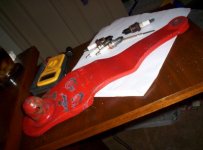Soundguy
Old Timer
- Joined
- Mar 11, 2002
- Messages
- 52,238
- Location
- Central florida
- Tractor
- RK 55HC,ym1700, NH7610S, Ford 8N, 2N, NAA, 660, 850 x2, 541, 950, 941D, 951, 2000, 3000, 4000, 4600, 5000, 740, IH 'C' 'H', CUB, John Deere 'B', allis 'G', case VAC
I just recieved my bracket set fro my ford 711/722 loader. i notice there is an older weld repair to the bracket ( upright support on bellhousing ). It's an older repair.. obviously has been painted over, installed and used, based on what the paint and wear marks look like.. so thus.. I'm sure the weld was 'good enough'./
However.. i can still see a few flaws and cracks in a place or two, and I want to re-weld it.. That is.. v-cut the cracked areas and lay a few beads, and then regring. perhaps leave the beads proud on the areas that don't have clearance issues, in order to get a bit more metal on it.
My question is this:
I have much more exp with stick, and have a 235ac hobart stickmate.. I got a variety of rods.. mostly I use 6011 and 6013.. though I do have some 7014 and 7018 ac rods.
I'm guessing 60xx is ok tensile str.. and i will probably go with 6011 for deep penetration.. and mid to high ont he amps. Metal is 1/2 and 3/8 inch in some palces.. so i want to get 100% penetration by going at it from both sides.
Now.. i also have access to a ? miller 225a mig welder at work.. I have mig welded a little... I can draw a bead..e tc. though I feel -way- more confident in my stick welding skills.
Anyone see a problem in stick welding it to re-repair it?
Here is a photo of the bracket. Break occoured just above the bolt holes.. at a diagonal thru one hole.. bracket does not appear to have broken all the way.. just thru a hole.. etc. Old weld has obviously held.. but looks like the guy only had just enough rod to glue the big cracks together... and left the small ones..
opinions?
Soundguy
However.. i can still see a few flaws and cracks in a place or two, and I want to re-weld it.. That is.. v-cut the cracked areas and lay a few beads, and then regring. perhaps leave the beads proud on the areas that don't have clearance issues, in order to get a bit more metal on it.
My question is this:
I have much more exp with stick, and have a 235ac hobart stickmate.. I got a variety of rods.. mostly I use 6011 and 6013.. though I do have some 7014 and 7018 ac rods.
I'm guessing 60xx is ok tensile str.. and i will probably go with 6011 for deep penetration.. and mid to high ont he amps. Metal is 1/2 and 3/8 inch in some palces.. so i want to get 100% penetration by going at it from both sides.
Now.. i also have access to a ? miller 225a mig welder at work.. I have mig welded a little... I can draw a bead..e tc. though I feel -way- more confident in my stick welding skills.
Anyone see a problem in stick welding it to re-repair it?
Here is a photo of the bracket. Break occoured just above the bolt holes.. at a diagonal thru one hole.. bracket does not appear to have broken all the way.. just thru a hole.. etc. Old weld has obviously held.. but looks like the guy only had just enough rod to glue the big cracks together... and left the small ones..
opinions?
Soundguy
